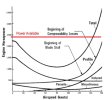I thought there was another aero thread, but I can't find it. And because I am so fucking tired of dealing with former or current Army IPs who don't seem to understand what they're teaching, I'm hoping the TPS and Aero-smart people can help...
I plan to peruse Aerodynamics for Naval Aviators this week while I'm at work, but I'm thinking that may be a bit too technical for what I'm trying to figure out. This video is a great break down of Vspeeds for helicopters (it's 10 minutes, but you can skip through it), but he's using a chart that I haven't really dealt with (or at least, not what he's calling it). No big deal, as it's clear it's a power chart, mirrored and then rotated 90 degrees.
I'm completely comfortable with what Vy and Vx (or Vtoss if you sprechen EuroDeutch) are practically. What I'm trying to understand is the math and why is Vx not at the bucket and why is Vy not slightly "higher" than the bucket on his chart. Yeah, it's a crude drawing, so it could just be the way it's laid out, but on the Ps diagrams, Ps max was always at the bucket (if I'm remembering correctly). And you never really had to figure out where Vy was, so other than knowing it's "more" than Vx, you didn't have to do anything else.
I may not be asking the question clearly enough, so I can elaborate as needed, but at the end of the day, I'm trying to figure out an easy way to explain Vy to someone that seems to think "best rate" means the highest VSI, which isn't the case. And as a result, what they're teaching is going to put people into trees if someone loses an engine.
I plan to peruse Aerodynamics for Naval Aviators this week while I'm at work, but I'm thinking that may be a bit too technical for what I'm trying to figure out. This video is a great break down of Vspeeds for helicopters (it's 10 minutes, but you can skip through it), but he's using a chart that I haven't really dealt with (or at least, not what he's calling it). No big deal, as it's clear it's a power chart, mirrored and then rotated 90 degrees.
I'm completely comfortable with what Vy and Vx (or Vtoss if you sprechen EuroDeutch) are practically. What I'm trying to understand is the math and why is Vx not at the bucket and why is Vy not slightly "higher" than the bucket on his chart. Yeah, it's a crude drawing, so it could just be the way it's laid out, but on the Ps diagrams, Ps max was always at the bucket (if I'm remembering correctly). And you never really had to figure out where Vy was, so other than knowing it's "more" than Vx, you didn't have to do anything else.
I may not be asking the question clearly enough, so I can elaborate as needed, but at the end of the day, I'm trying to figure out an easy way to explain Vy to someone that seems to think "best rate" means the highest VSI, which isn't the case. And as a result, what they're teaching is going to put people into trees if someone loses an engine.



